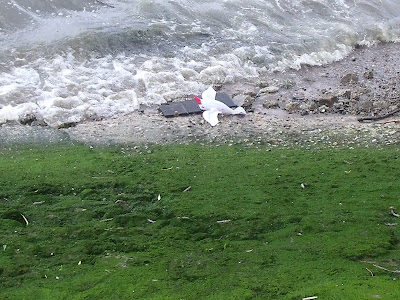This blog records my wanderings, achievements and disasters since retiring in 2011.
Sunday, 30 June 2013
Friday, 28 June 2013
Weekend reflection of the O2
This building is next to the O2 (previously called the Millennium Dome). One wall of the building is covered with these porthole shaped windows. I could just see a little of the Dome reflected in them.
The building is part of Ravensbourne College of Design and Communication which has recently moved to the Greenwich Peninsula. I loved seeing the bright blue sky reflected in all those windows.

The building is part of Ravensbourne College of Design and Communication which has recently moved to the Greenwich Peninsula. I loved seeing the bright blue sky reflected in all those windows.

Greenwich Fair 2013
The annual Greenwich Fair festival took place this week in different parts of Greenwich. Here at the Old Royal Naval College there were a number of different performances happening from dance, theatre, circus and other forms of street art. The festival is free and with the sun shining it was a great place for a picnic.
Thursday, 27 June 2013
Vanishing acts
This was a display of work by the artist Lalla Ward in the National Theatre on the South bank of the Thames. The exhibition was called Vanishing Acts. Inspired by nature the textiles were beautiful but difficult to capture because of the reflections from the glass display cabinets. This was my favourite. Can you spot the frog?
Also displayed were wood turnings by Nicholas Kettlewood
Wednesday, 26 June 2013
A sign of things to come
An electric car plugged in to a recharging post.
These recharging posts are becoming a more familiar sight in and around London. I have even noticed them in a supermarket car park. Electric cars do not have to pay the congestion charge of £10 per day when entering the congestion zones in London. Trying to keep a large city free from car emissions is not easy and charging to enter the city is one possible way of restricting traffic flow but there is still so much traffic you hardly know the difference. Do many cities charge for driving a car into their centres?
Monday, 24 June 2013
Leadenhall market

 In 1881 the market was redesigned and the stone structures replaced with wrought iron and glasswork.
In 1881 the market was redesigned and the stone structures replaced with wrought iron and glasswork.Sharing with 'Our World Tuesday'
Sunday, 23 June 2013
Saturday, 22 June 2013
Eastbourne
I have just returned from a couple of days in Eastbourne. This is a small town on the South Sussex coast. The main reason for visiting was to watch yet more tennis and also to look a t a couple of National Trust properties in the Sussex area.
The beach at Eastbourne is a pebble beach, so I never brought the children here when they were young as sand was a must.
But it does have a pier. Piers were built at many seaside towns during the Victorian era to provide a landing stage for the passenger ships from across the channel.
Some of the original pier, where I assume the passengers used to disembark.
A couple of paddle boarders enjoying the last rays of sunshine.
The beach at Eastbourne is a pebble beach, so I never brought the children here when they were young as sand was a must.
But it does have a pier. Piers were built at many seaside towns during the Victorian era to provide a landing stage for the passenger ships from across the channel.
I love the Victorian iron work that is still evident around the seating areas.
Some of the original pier, where I assume the passengers used to disembark.
A couple of paddle boarders enjoying the last rays of sunshine.
Friday, 21 June 2013
Thursday, 20 June 2013
Thank-you
I would like to say a huge thank-you to all of you fellow bloggers who took the time and trouble to answer my query with regard to reading my posts. All seems to be well and I don't have to worry about changing the way I post.
The Royal College of Physicians
The college of physicians was established in 1518 by the royal physician to Henry VIII. The purpose of the college was to grant licences to those qualified to practise medicine and to punish those who were unqualified. Unfortunately the original building was destroyed in the Great fire of London in 1666 including a large library donated by William Harvey who discovered the circulation of blood. The present headquarters was built in 1958.
The panelling in this room is made from 350yr old oak which had been used in their previous building.
This plant was the source of opium for 2000 years.
House leek: multiple uses in herbal medicine from removing warts and treating shingles
Pacific bleeding heart: herbal remedy for toothache and worms
Other things of interest included the medieval illustrations of the human body.
The college also holds a rare set of six anatomical tables which are the oldest surviving human anatomy diagrams. They display veins, nerves and arteries arranged on varnished wooden panels.
The College is not often open to the public so it was a rare opportunity for me to see these treasures.
The panelling in this room is made from 350yr old oak which had been used in their previous building.
The Dorchester library which had a photographic display in there, showing plants and there medicinal uses.
This plant was the source of opium for 2000 years.
House leek: multiple uses in herbal medicine from removing warts and treating shingles
Other things of interest included the medieval illustrations of the human body.
The college also holds a rare set of six anatomical tables which are the oldest surviving human anatomy diagrams. They display veins, nerves and arteries arranged on varnished wooden panels.
The College is not often open to the public so it was a rare opportunity for me to see these treasures.
Tuesday, 18 June 2013
Highlights from London Squares
Here are some of my favourite views from the squares I visited last week. The Squares are all part of the Grovenor estate which is responsible for the landscape and maintenance of these squares.
History of the Grovenor estate taken from its website: The family's ownership of the London Estate dates back to the marriage of Mary Davies to Sir Thomas Grosvenor in 1677. Mary inherited an area known as the Five Fields (500 acres situated north of the Thames and to the west of the City of London) which today are occupied by Mayfair, Belgravia and Pimlico.
This is the laburnan archway in full flower in Warwick square. This and many other squares was designed by Thomas Cundy.
A very secluded seat
Chester Square.
These rules apply to all the private squares.
This tree with its bottle shaped trunk is the Oriental Plane.
In Eaton Square there was live music from a steel band
There were many sculptures in this large square.
History of the Grovenor estate taken from its website: The family's ownership of the London Estate dates back to the marriage of Mary Davies to Sir Thomas Grosvenor in 1677. Mary inherited an area known as the Five Fields (500 acres situated north of the Thames and to the west of the City of London) which today are occupied by Mayfair, Belgravia and Pimlico.
This landholding remained largely untouched by the family
until the 1720s when a decision was taken to develop the northern part - now
known as Mayfair – around a new Grosvenor Square. A few generations later, in
the 1820s, the focus shifted to what is now Belgravia, and work began to develop
Eaton Square, Chester Square and many other famous London addresses
This is the laburnan archway in full flower in Warwick square. This and many other squares was designed by Thomas Cundy.
A very secluded seat
Chester Square.
These rules apply to all the private squares.
This tree with its bottle shaped trunk is the Oriental Plane.
In Eaton Square there was live music from a steel band
There were many sculptures in this large square.
 |
Subscribe to:
Posts (Atom)
















































